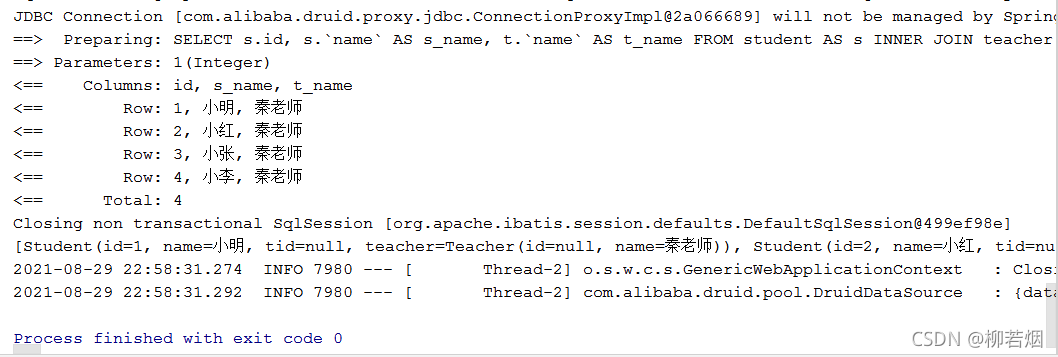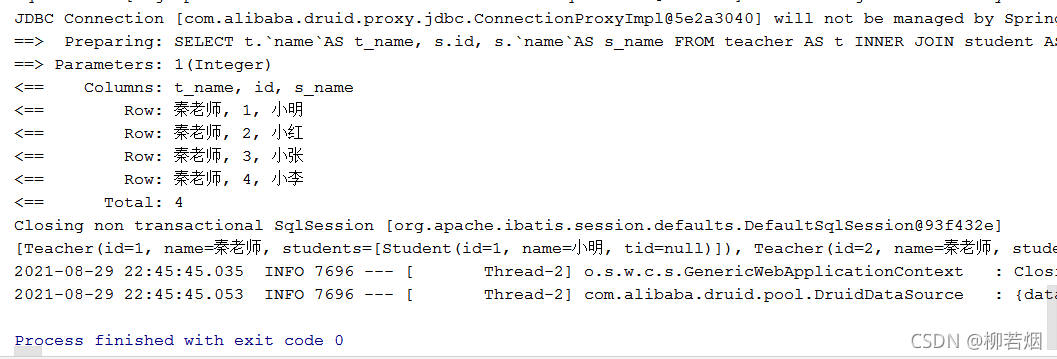目录
MyBatis 一对多和多对一处理
这里我们以老师和学生为例,一个老师对应多个学生,这是一对多;反过来,多个学生对应一个老师,这是多对一
MyBatis 参考文档:https://mybatis.org/mybatis-3/zh/getting-started.html 可以查看详细的XML 映射器
数据准备
CREATETABLE`teacher`(`id`INT(10)NOTNULL,`name`VARCHAR(30)DEFAULTNULL,PRIMARYKEY(`id`))ENGINE=INNODBDEFAULTCHARSET=utf8INSERTINTO teacher(`id`,`name`)VALUES(1,'秦老师');INSERTINTO teacher(`id`,`name`)VALUES(2,'张老师');CREATETABLE`student`(`id`INT(10)NOTNULL,`name`VARCHAR(30)DEFAULTNULL,`tid`INT(10)DEFAULTNULL,PRIMARYKEY(`id`),KEY`fktid`(`tid`),CONSTRAINT`fktid`FOREIGNKEY(`tid`)REFERENCES`teacher`(`id`))ENGINE=INNODBDEFAULTCHARSET=utf8INSERTINTO`student`(`id`,`name`,`tid`)VALUES('1','小明','1');INSERTINTO`student`(`id`,`name`,`tid`)VALUES('2','小红','1');INSERTINTO`student`(`id`,`name`,`tid`)VALUES('3','小张','1');INSERTINTO`student`(`id`,`name`,`tid`)VALUES('4','小李','1');INSERTINTO`student`(`id`,`name`,`tid`)VALUES('5','小王','2');INSERTINTO`student`(`id`,`name`,`tid`)VALUES('6','小刚','2');MyBatis 多对一处理
实体类
@DatapublicclassStudentimplementsSerializable{private Integer id;private String name;private Integer tid;// 数据库不存在的字段,与下面的 association 标签形成映射private Teacher teacher;}@DatapublicclassTeacherimplementsSerializable{private Integer id;private String name;}Service 层接口
List<Student>getStudents(Integer tid);mapper.xml 文件
<!--多对一处理示例,通过学生查找老师--><selectid="getStudents"parameterType="java.lang.Integer"resultMap="selectTeacher">
SELECT
s.id,
s.`name`,
t.`name`
FROM
student AS s
INNER JOIN teacher AS t ON s.tid = t.id
WHERE
s.tid = #{tid}</select><resultMapid="selectTeacher"type="com.atguigu.pojo.Student"><!--id:查询列中的唯一标识--><idcolumn="id"property="id"></id><!--<result property="映射到实体类的属性" column="表字段" jdbcType="字段类型"></result>--><resultcolumn="name"property="name"></result><!--关联对象 property 关联对象在 Student 实体类中的属性--><associationproperty="teacher"javaType="com.atguigu.pojo.Teacher"><resultcolumn="name"property="name"></result></association></resultMap>column:数据库表对应的字段;如果有别名,就是数据库查询出来的字段的别名property:与实体类对应的属性jdbcType:可以不用写会自动映射
测试类
@SpringBootTest@RunWith(SpringRunner.class)publicclassAppTest{@Autowiredprivate StudentServce studentServce;@TestpublicvoidshouldAnswerWithTrue(){
List<Student> students= studentServce.getStudents(1);
System.out.println(students);}}测试结果

MyBatis 一对多处理
实体类
@DatapublicclassStudentimplementsSerializable{private Integer id;private String name;private Integer tid;}@DatapublicclassTeacherimplementsSerializable{private Integer id;private String name;// 数据库不存在的字段,与下面的 collection 标签形成映射private List<Student> students;}Service 层接口
List<Teacher>getTeacher(Integer id);mapper.xml 文件
<!--一对多处理,通过教师查询学生--><selectid="getTeacher"parameterType="java.lang.Integer"resultMap="selectTeacher">
SELECT
t.`name`AS t_name,
s.id,
s.`name`AS s_name
FROM
teacher AS t
INNER JOIN student AS s ON t.id = s.tid
WHERE
t.id = #{id}</select><resultMapid="selectTeacher"type="com.atguigu.pojo.Teacher"><idcolumn="id"property="id"></id><resultcolumn="t_name"property="name"></result><collectionproperty="students"ofType="com.atguigu.pojo.Student"><idcolumn="id"property="id"></id><resultcolumn="s_name"property="name"></result></collection></resultMap>column:数据库表对应的字段;如果有别名,就是数据库查询出来的字段的别名property:与实体类对应的属性jdbcType:可以不用写会自动映射ofType:映射的属性(集合)中实体对象的类型
测试类
@SpringBootTest@RunWith(SpringRunner.class)publicclassAppTest{@Autowiredprivate TeacherService teacherService;@TestpublicvoidfindByTeacherToStudent(){
List<Teacher> teachers= teacherService.getTeacher(1);
System.out.println(teachers);}}测试结果
